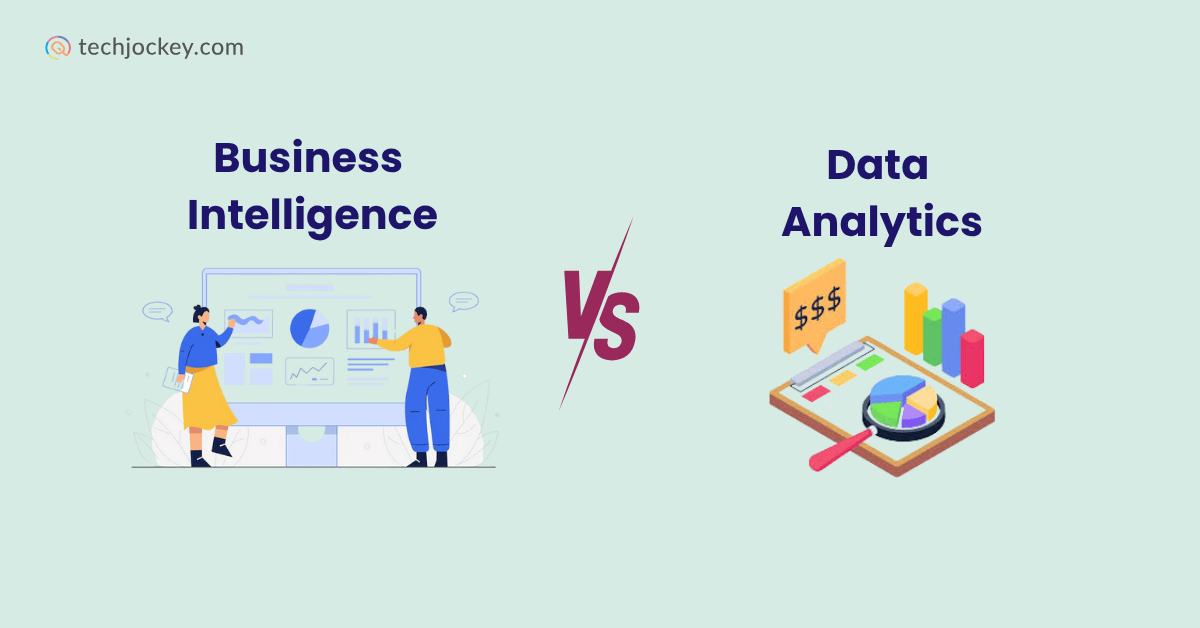
Data is the most valuable asset for any business. It provides critical insights that help identify both the strengths and weaknesses in your operations. According to a report by McKinsey, companies that effectively use data in their workflows are 23 times more likely to acquire customers and 6 times more likely to retain them.
When it comes to leveraging data, Business Intelligence vs Data Analytics is a common comparison that often arises. While both are essential for data-driven decision-making, they serve different purposes. Understanding these differences can help you make smarter strategic choices and better determine what will drive client growth and long-term success.
Business intelligence often focuses on historical data and reporting to support business decisions, whereas data analytics dives deeper into patterns and trends to forecast future outcomes and optimize processes. Both play a crucial role in identifying gaps and reinforcing solid structures within your organization.
Let’s interpret the key differences and how each can benefit your business.
Business intelligence in action is to check out what’s going on in your business and what has already happened in the past. With BI, you can turn raw data into useful reports, charts, and dashboards to make your operations better.
In simple terms, BI is the process where you collecting, organizing, and visualize data, and make decisions based on that. It generally shows you the current state of your business.
While BI gives you clear dashboards and reports on the surface, there’s a powerful process working in the background:
This is a simple approach towards making smart decisions and planning for the long term.
Microsoft Power BI
Starting Price
₹ 1260.00 excl. GST
Mostly business managers, operations teams, and executives who need quick answers like:
BI is a complete toolset for the people involved in decision-making.
While business intelligence helps you make daily decisions, Data analytics gives you more clarity on what can happen next and what actions you must take.
It’s about predicting your future outcomes.
Business intelligence only focuses on what is happening or what has happened, but in data analytics, there is a team of data experts who dig deeper and ask questions like:
Zoho Analytics
Starting Price
₹ 1200.00 excl. GST
Let’s break this down with a simple example, like you are running an e-commerce store.
1. Descriptive Analytics – What happened?
It focuses on past events and uses reports and dashboards to find out the loopholes.
For example, Sales dropped by 10% last month. You’re looking at the facts.
2. Diagnostic Analytics – Why it happened?
In this, you find the root cause of declining sales in the past.
For example, Sales dropped because 20% of returning customers didn’t make a purchase.
3. Predictive Analytics – What will happen next?
This helps you forecast future outcomes using techniques like regression, machine learning, and time series analysis.
For example, If the trend continues, sales may drop again this month.
4. Prescriptive Analytics – What must we do next?
It’s the next step to predictions. It suggests further actions using big data and machine learning.
For example, offer a personalized discount to returning customers to increase conversions.
Datamatics TruBI
Starting Price
Price on Request
With analytics, businesses can:
EasyInsights
Starting Price
₹ 21000.00 excl. GST
| Factor | Business Intelligence | Data Analytics |
|---|---|---|
| Focus | Past & present data | Trends & future outcomes |
| Goal | Operational decision-making | Strategic planning |
| Techniques | Reporting, dashboards | Statistical analysis, modeling |
| Users | Business managers | Analysts, data scientists |
| Tools | Power BI, Tableau | Python, R, SAS |
Here’s a detailed version of Business Intelligence vs Data Analytics:
BI uses tools such as dashboards, scorecards, and reports to make things easier to understand.
Data analytics involves statistical models, algorithms, and even machine learning to know about why” and what next”.
BI is used by business managers and operations teams to offer fast and high-level views of business performance.
Analytics allow data analysts, scientists, and strategic planners to test their hypotheses, investigate insights, and design actions to be taken in the future.
Some Business Intelligence software are Power BI, Tableau, and Qlik, but these are limited to visualisation and reporting purposes.
Python, R, and SAS are data analytics tools used in data exploration, modeling, and prediction.
Of course, they can, and they should.
Most companies tend to believe that these two are competing technologies. Actually, they have distinct functions but complement each other perfectly.
Consider it in this manner:
Combined, they can tell you the whole image, including the present situation and the future prospect.
Consider that you are the manager of a retail chain.
In this manner, BI warns you, and analytics informs you.
Combined with analytics, BI contributes to both efficiency and innovation and makes your business more proactive, more agile, and competitive.
Conclusion: What Should Your Business Do Next?
Business Intelligence vs Data Analytics are not competitors but rather complementary tools.
BI is useful to make sure you watch what is already occurring, whereas analytics provides you with the knowledge to plan what should occur next.
When you are new to it, start with BI as it explains it better. As you acquire more data, begin to embrace analytics as you make more intelligent, visionary decisions.
In the modern data-oriented world, a combination of both is a ticket towards being agile, informed, and competitive.
Android trojan, for the unversed, is malware that poses a serious threat to mobile… Read More
Smartphones have completely transformed how we bank, making money transfers and payments quicker and more… Read More
Ever come across an AI chatbot giving weird medical tips? Or one, as hiring… Read More
Recruiting now does not occur over table-it mostly begins on a screen. This has… Read More
Did you know approximately two-thirds of total organizations who use generative AI have deployed it… Read More
How would you feel if your organization was under attack and you had no idea… Read More